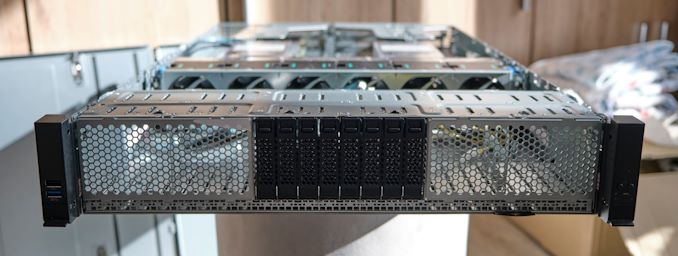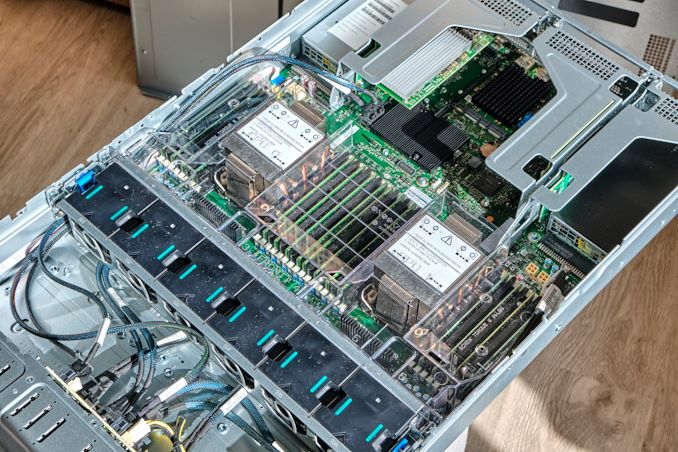Intel 3rd Gen Xeon Scalable (Ice Lake SP) Review: Generationally Big, Competitively Small
by Andrei Frumusanu on April 6, 2021 11:00 AM EST- Posted in
- Servers
- CPUs
- Intel
- Xeon
- Enterprise
- Xeon Scalable
- Ice Lake-SP
Test Bed and Setup - Compiler Options
For the rest of our performance testing, we’re disclosing the details of the various test setups:
Intel - Dual Xeon Platinum 8380
For our new Ice Lake test system based on the Whiskey Lake platform, we’re using Intel’s SDP (Software Development Platform 2SW3SIL4Q, featuring a 2-socket Intel server board (Coyote Pass).
The system is an airflow optimised 2U rack unit with otherwise little fanfare.
Our review setup solely includes the new Intel Xeon 8380 with 40 cores, 2.3GHz base clock, 3.0GHz all-core boost, and 3.4GHz peak single core boost. That’s unusual about this part as noted in the intro, it’s running at a default 205W TDP which is above what we’ve seen from previous generation non-specialised Intel SKUs.
| CPU | 2x Intel Xeon Platinum 8380 (2.3-3.4 GHz, 40c, 60MB L3, 270W) |
| RAM | 512 GB (16x32 GB) SK Hynix DDR4-3200 |
| Internal Disks | Intel SSD P5510 7.68TB |
| Motherboard | Intel Coyote Pass (Server System S2W3SIL4Q) |
| PSU | 2x Platinum 2100W |
The system came with several SSDs including Optane SSD P5800X’s, however we ran our test suite on the P5510 – not that we’re I/O affected in our current benchmarks anyhow.
As per Intel guidance, we’re using the latest BIOS available with the 270 release microcode update.
Intel - Dual Xeon Platinum 8280
For the older Cascade Lake Intel system we’re also using a test-bench setup with the same SSD and OS image as on the EPYC 7742 system.
Because the Xeons only have 6-channel memory, their maximum capacity is limited to 384GB of the same Micron memory, running at a default 2933MHz to remain in-spec with the processor’s capabilities.
| CPU | 2x Intel Xeon Platinum 8280 (2.7-4.0 GHz, 28c, 38.5MB L3, 205W) |
| RAM | 384 GB (12x32 GB) Micron DDR4-3200 (Running at 2933MHz) |
| Internal Disks | Crucial MX300 1TB |
| Motherboard | ASRock EP2C621D12 WS |
| PSU | EVGA 1600 T2 (1600W) |
The Xeon system was similarly run on BIOS defaults on an ASRock EP2C621D12 WS with the latest firmware available.
AMD - Dual EPYC 7763 / 7713 / 75F3 / 7662
In terms of testing the new EPYC 7003 series CPUs, unfortunately due to our malfunctioning Daytona server, we weren’t able to get first-hand experience with the hardware. AMD graciously gave us remote access to one of their server clusters – we had full controls of the system in terms of BMC as well as BIOS settings.
| CPU | 2x AMD EPYC 7763 (2.45-3.500 GHz, 64c, 256 MB L3, 280W) / 2x AMD EPYC 7713 (2.00-3.365 GHz, 64c, 256 MB L3, 225W) / 2x AMD EPYC 75F3 (3.20-4.000 GHz, 32c, 256 MB L3, 280W) / 2x AMD EPYC 7662 (2.00-3.300 GHz, 64c, 256 MB L3, 225W) |
| RAM | 512 GB (16x32 GB) Micron DDR4-3200 |
| Internal Disks | Varying |
| Motherboard | Daytona reference board: S5BQ |
| PSU | PWS-1200 |
Software wise, we ran Ubuntu 20.10 images with the latest release 5.11 Linux kernel. Performance settings both on the OS as well on the BIOS were left to default settings, including such things as a regular Schedutil based frequency governor and the CPUs running performance determinism mode at their respective default TDPs unless otherwise indicated.
AMD - Dual EPYC 7742
Our local AMD EPYC 7742 system, due to the aforementioned issues with the Daytona hardware, is running on a SuperMicro H11DSI Rev 2.0.
| CPU | 2x AMD EPYC 7742 (2.25-3.4 GHz, 64c, 256 MB L3, 225W) |
| RAM | 512 GB (16x32 GB) Micron DDR4-3200 |
| Internal Disks | Crucial MX300 1TB |
| Motherboard | SuperMicro H11DSI0 |
| PSU | EVGA 1600 T2 (1600W) |
As an operating system we’re using Ubuntu 20.10 with no further optimisations. In terms of BIOS settings we’re using complete defaults, including retaining the default 225W TDP of the EPYC 7742’s, as well as leaving further CPU configurables to auto, except of NPS settings where it’s we explicitly state the configuration in the results.
The system has all relevant security mitigations activated against speculative store bypass and Spectre variants.
Ampere "Mount Jade" - Dual Altra Q80-33
The Ampere Altra system we’re using the provided Mount Jade server as configured by Ampere. The system features 2 Altra Q80-33 processors within the Mount Jade DVT motherboard from Ampere.
In terms of memory, we’re using the bundled 16 DIMMs of 32GB of Samsung DDR4-3200 for a total of 512GB, 256GB per socket.
| CPU | 2x Ampere Altra Q80-33 (3.3 GHz, 80c, 32 MB L3, 250W) |
| RAM | 512 GB (16x32 GB) Samsung DDR4-3200 |
| Internal Disks | Samsung MZ-QLB960NE 960GB Samsung MZ-1LB960NE 960GB |
| Motherboard | Mount Jade DVT Reference Motherboard |
| PSU | 2000W (94%) |
The system came preinstalled with CentOS 8 and we continued usage of that OS. It’s to be noted that the server is naturally Arm SBSA compatible and thus you can run any kind of Linux distribution on it.
The only other note to make of the system is that the OS is running with 64KB pages rather than the usual 4KB pages – this either can be seen as a testing discrepancy or an advantage on the part of the Arm system given that the next page size step for x86 systems is 2MB – which isn’t feasible for general use-case testing and something deployments would have to decide to explicitly enable.
The system has all relevant security mitigations activated, including SSBS (Speculative Store Bypass Safe) against Spectre variants.
The system has all relevant security mitigations activated against the various vulnerabilities.
Compiler Setup
For compiled tests, we’re using the release version of GCC 10.2. The toolchain was compiled from scratch on both the x86 systems as well as the Altra system. We’re using shared binaries with the system’s libc libraries.












169 Comments
View All Comments
mode_13h - Monday, April 12, 2021 - link
With regard specifically to testing AVX-512, perhaps the best method is to include results both with and without it. This serves the dual-role of informing customers of the likely performance for software compiled with more typical options, as well as showing how much further performance is to be gained by using an AVX-512 optimized build.KurtL - Wednesday, April 7, 2021 - link
GCC the industry standard in real world? Maybe in that part of the world where you live, but not everywhere. It is only true in a part of the world. HPC centres have relied on icc for ages for much of the performance-critical code, though GCC is slowly catching up, at least for C and C++ but not at all for Fortran, an important language in HPC (I just read it made it back in the top-20 of most used languages after falling back to position 34 a year or so ago). In embedded systems and the non-x86-world in general, LLVM derived compilers have long been the norm. Commercial compiler vendors and CPU manufacturers are all moving to LLVM-based compilers or have been there for years already.Wilco1 - Wednesday, April 7, 2021 - link
Yes GCC is the industry standard for Linux. That's a simple fact, not something you can dispute.In HPC people are willing to use various compilers to get best performance, so it's certainly not purely ICC. And HPC isn't exclusively Intel or x86 based either. LLVM is increasing in popularity in the wider industry but it still needs to catch up to GCC in performance.
mode_13h - Wednesday, April 7, 2021 - link
GCC is the only supported compiler for building the Linux kernel, although Google is working hard to make it build with LLVM. They seem to believe it's better for security.From the benchmarks that Phoronix routinely publishes, each has its strengths and weaknesses. I think neither is a clear winner.
Wilco1 - Thursday, April 8, 2021 - link
Plus almost all distros use GCC - there is only one I know that uses LLVM. LLVM is slowly gaining popularity though.They are fairly close for general code, however recent GCC versions significantly improved vectorization, and that helps SPEC.
Wilco1 - Tuesday, April 6, 2021 - link
ICC and AMD's AOCC are SPEC trick compilers. Neither is used much in the real world since for real code they are typically slower than GCC or LLVM.Btw are you equally happy if I propose to use a compiler which replaces critical inner loops of the benchmarks with hand-optimized assembler code? It would be foolish not to take advantage of the extra performance you get only on those benchmarks...
ricebunny - Tuesday, April 6, 2021 - link
They are not SPEC tricks. You can use these compilers for any compliant C++ code that you have. In the last 10 years, the only time I didn’t use icc with Intel chips was on systems where I had no control over the sw ecosystem.Wilco1 - Tuesday, April 6, 2021 - link
They only exist because of SPEC. The latest ICC is now based on LLVM since it was falling further behind on typical code.ricebunny - Tuesday, April 6, 2021 - link
From my experience icc consistently produced better vectorized code.Anandtech again didn’t publicize the compiler flags they used to build the benchmark code. By default, gcc will not generate avx512 optimized code.
Wilco1 - Tuesday, April 6, 2021 - link
Maybe compared to old GCC/LLVM versions, but things have changed. There is now little difference between ICC and GCC when running SPEC in terms of vectorized performance. Note the amount of code that can benefit from AVX-512 is absolutely tiny, and the speedups in the real world are smaller than expected (see eg. SIMDJson results with hand-optimized AVX-512).And please read the article - the setup is clearly explained in every review: "We compile the binaries with GCC 10.2 on their respective platforms, with simple -Ofast optimisation flags and relevant architecture and machine tuning flags (-march/-mtune=Neoverse-n1 ; -march/-mtune=skylake-avx512 ; -march/-mtune=znver2 (for Zen3 as well due to GCC 10.2 not having znver3). "